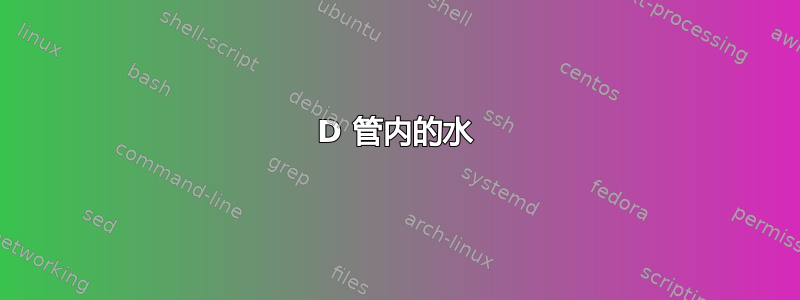

我如何使用 TikZ 生成上述图像。管内的椭圆代表水,箭头表示水的偶极子方向。我目前能够得到的结果粘贴在下面。
\documentclass{article}
\usepackage{tikz}
\usepackage{tikz-3dplot}
%%%<
\usepackage{verbatim}
\usepackage[active,tightpage]{preview}
\PreviewEnvironment{tikzpicture}
\setlength\PreviewBorder{5pt}%
%%%>
\begin{document}
\tdplotsetmaincoords{30}{10}
\tikzset{every circle/.append style={x=1cm, y=1cm}}
\begin{tikzpicture}[tdplot_main_coords, rotate=90]
% --- Independent parameters ---
\pgfmathtruncatemacro\tA{3600} % 10 turns 360 degree x 10=3600
\def\zA{1} % A begin point, define the length of cylinder
\pgfmathtruncatemacro\tB{30} % tB end of turn
\def\zB{5} % B end point
\pgfmathtruncatemacro\NbPt{130} % number of circles for drawing the helix portion 13 times 10 turns =130
\def\rhelixdots{0.14} % radius of circles forming helix
% --- Draw helix ---
\pgfmathsetmacro\tone{\tA}
\pgfmathsetmacro\tlast{\tB}
\pgfmathsetmacro\ttwo{\tone+(\tlast-\tone)/(\NbPt-1)}
\pgfmathsetmacro\p{360*(\zB-\zA)/(\tB-\tA)}
\foreach \t in {\tone,\ttwo,...,\tlast}{%
\pgfmathtruncatemacro{\shadingcolor}{40*sin(\t+180)+80}
\shade[ball color=blue!\shadingcolor] ({0.7*cos(\t)},{0.7*sin(\t)},{\p*(\t-\tA)/360+\zA}) circle[radius=\rhelixdots];
\shade[ball color=red!\shadingcolor] ({0.7*cos(\t)},{0.7*sin(\t)},{\p*(\t-\tA)/360+\zA+0.2}) circle[radius=\rhelixdots];
}
\end{tikzpicture}
\end{document}

寻求帮助,请同时查看此帖子改变视角会扭曲 3D 管图像
答案1
按照正确的顺序绘制所有内容比使用 3d 坐标(或图层)要容易得多。
关键的是最后十几行:
\documentclass{standalone}
\usepackage{xifthen}
\usepackage{tikz}
\usetikzlibrary{math}
\begin{document}
\begin{tikzpicture}
\newdimen\r
\newdimen\R
\newcount\n
\tikzmath{
\n = 19; % Molecules per winding
\R = 100pt; % Tube radius
\e = 0.9; % Eccentricity
\t = 1.15; % Tightening factor
\F = floor(\n/2); % Crucial to perform the clever cycles
\G = \n-\F; % (see the interesting part)
\r = \R*sin(180/\n)*\t; % 1/2 side of regular n-polygon, times t
}
% ##################################################### START OF BORING PART #
% These are the basic styles.
\tikzset{
spirals/.cd,
0/.style={draw, fill=white!70!black}, % {shade, ball color=white}
1/.style={draw, fill=white!90!black}, % {shade, ball color=gray}
8/.style={draw, fill=white!20!black}, % {shade, ball color=black}
9/.style={opacity=0}
}
% Shaping the border. Boring.
\newcommand\ifisborderthen[4]{
\ifthenelse{
\(#2=0 \AND #3=0\)
\OR \(#1=16 \AND #2<5\)
\OR \(#1=3 \AND #2<1\)
\OR \( #1=1 \AND \( #2<7 \OR \(#2<8 \AND #3=0\) \) \)
\OR \( \(#1=17 \OR #1=2 \) \AND \(#2<5 \OR \(#2<6 \AND #3=0\)\) \)
\OR \( \(#1=18 \OR #1=19\) \AND \(#2<6 \OR \(#2<7 \AND #3=0\)\) \)
}{#4}{}}
% Shaping the hole. Boring.
\newcommand\ifisholethen[4]{
\ifthenelse{
\( #2<4 \AND \(2>#1 \OR #1>16\) \)
\OR \(#1=1 \AND #2<5\)
\OR \(#1=2 \AND #2<1 \AND #3=0\)
\OR \(#1=19 \AND #2<6\)
\OR \(#1=18 \AND #2<5\)
\OR \(#1=17 \AND #2<5 \AND #3=0\)
}{#4}{}}
% ################################################# START OF INTERESTING PART #
% We define a parametric key to apply the styles in a convenient way
\tikzset{
molecule/.code args={#1in winding #2of spiral #3}{ % <-- HOCKETY POCKETY
\tikzset{spirals/#3} % Draw everything.
\ifisborderthen{#1}{#2}{#3}{\tikzset{spirals/8}} % Mark Borders.
\ifisholethen{#1}{#2}{#3}{\tikzset{spirals/9}}}} % Punch holes.
\foreach \a [evaluate = \a using int(\a)] % We cross (nearing viewer)
in { \F, ..., 1 % first the lower side and
, \F+1, \F+2, \F+..., \F+\G } % then the upper side
\foreach \z in {0, ..., 9} % of ten windings
\foreach \h in {0, 1} % of two spirals.
\path [molecule = \a in winding \z of spiral \h] % <--- HIGITUS FIGITUS
( {sqrt(1-\e^2)*\R*cos(-\a*360/\n)} % This is the parametrization
, { \R*sin(-\a*360/\n)} ) % of an ellipse.
++ ({\a*2*2*\r/\n}, 0) % We cut them open and
++ ({\z*2*2*\r} , 0) % join them. Hence, spirals
++ ({\h*2*\r} , 0) % that we intertwine.
++ (rand*360:rand*\r/20) % Some wobblyness.
circle (\r);
\end{tikzpicture}
\end{document}
结果如下:
我没有画里面的东西,因为我看不懂。我没有使用仿 3D 球,因为我觉得它们太丑了。
深度多雾路段效果(或球)很容易添加,而且您已经知道如何添加。我专注于重现给定的图片。
更新!!它是 3D 的!
新的样式在里面的评论中spirals。
更新2!!这是 3D 版本!
有趣的是,阴影仅占用第一个坐标。例如,比较上一个图(其中阴影仅使用沿椭圆的坐标计算)与下图(其中使用圆的完整坐标,但抖动校正除外):
\path [molecule = \a in winding \z of spiral \h] % <--- HIGITUS FIGITUS
( {sqrt(1-\e^2)*\R*cos(-\a*360/\n) % Ellipses parametrized.
+ \a*2*2*\r/\n % We cut them open and
+ \z*2*2*\r % join them. Hence, spirals
+ \h*2*\r } % that we intertwine.
, { \R*sin(-\a*360/\n)} )
++ (rand*360:rand*\r/20) % Some wobblyness.
circle (\r);
我一开始没有意识到,但这允许一些技巧。例如,考虑这个简单的排列:
\path [molecule = \a in winding \z of spiral \h]
({\a*2*2*\r/\n}, 0)
++ ({\z*2*2*\r} , 0)
++ ({\h*2*\r} , 0)
++ (rand*360:rand*\r/20)
++( {sqrt(1-\e^2)*\R*cos(-\a*360/\n)}
, { \R*sin(-\a*360/\n)} )
circle (\r);
看起来就像管子里面的一个点光源。太棒了!






